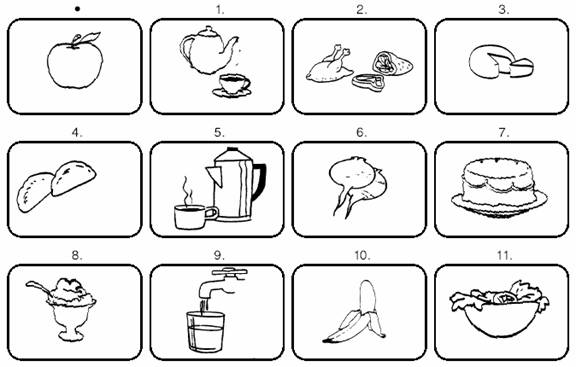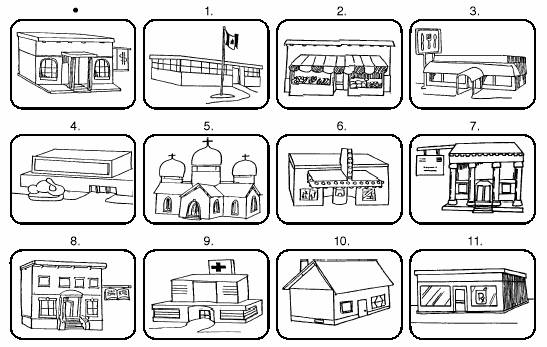
Lesson 2 of Unit XVI takes a close look at the Genitive and Accusative Cases. Your knowledge of the Genitive Case will be extended a great deal and will include several new patterns of use. You will also learn the names of some implements/tools commonly used around the house.
| |
Певно, що… |
Of course … |
| |
Гаразд! |
Alright! Okay! |
| |
ось |
and here is… (to emphasize location) |
| |
по дорозі... |
on the way (to or from)… |
| |
Чому ні? |
Why not? |
 |
У розмові ми чуємо: |
Певно, що до тебе!
|
 |
|
Гаразд! Дайте список!
|
 |
|
Ось олівець і папір!
|
 |
|
Тарасе, по дорозі додому зайди до крамниці!
|
 |
|
Чому ні? А тепер спіши до школи!
|
 |
|
The phrase тому що
The Ukrainian phrase for the word ‘because’ is тому що. This phrase is usually used in a sentence which answers the question Чому? Literally, the phrase can be taken to mean ‘and that is why’.
You know from English grammar study that it is incorrect to begin a sentence with the word ‘because’. This same rule applies in Ukrainian when using the phrase тому що. The phrase should appear within a sentence, as shown in the examples below.
Чому ти не снідаєш?
Я не снідаю тому, що я спішу до школи.
Чому мама не грає в теніс?
Мама не грає в теніс тому, що вона йде на концерт.
Please note that the words тому що are always separated by a comma when used in a sentence.
XVI. Exercise 2.i
To help you to review and remember the new expressions, complete the sentences/questions by using each expression once. Review your answers orally with your instructor.
| певно, що |
гаразд |
ось |
тому, що |
по дорозі |
чому ні |
1. Даниле, чи ти знаєш, де мої сині рукавиці?
______________________________________________________________
2. Сьогодні так холодно надворі, але я хочу йти до кінотеатру! Чи можна, мамо?
______________________________________________________________
3. А де шкарпетки й штани?
______________________________________________________________
4. Чому ви не хочете вставати, діти?
______________________________________________________________
5. Чи можеш купити цукерків для Петрика?
______________________________________________________________
6. Чи ми можемо йти на футбол, а не на баскетбол, після обіду?
_____________________________________________________________
|
Іменники: Родовий Відмінок
|
You have already learned about the Genitive Case and its use after the preposition до (to) in previous Units. Unit XVI introduces its use after the preposition для (for).
 |
У розмові ми чуємо: |
Чи не купити цукерків* для Перика?
*цукерків (Genitive plural - candies)
|
 |
|
Review the Genitive singular endings given below.
| Чоловічий рід |
stem + a |
(брат --- брата) |
| |
й --- я |
(Сергій --- Сергія) |
| |
ь --- я |
(Василь --- Василя) |
| |
о --- а |
(список --- списка) |
| |
|
|
| Жіночий рід |
а --- и |
(Анна --- Анни, баба --- баби) |
| |
я --- і/ї |
(Таня --- Тані, Марія --- Марії) |
| |
|
|
| Середній рід |
о --- а |
(м’ясо ---м’яса, авто ---авта) |
Questioning patterns are easy to follow, as they usually contain the preposition (one exception - Куди?)
до: До кого? Куди? До чого?
для: Для когo? Для чого?
XVI. Exercise 2.ii
Для чого?
Complete the following exercise.

• |
Петрик |
Яблуко для Петрика.
|
1. |
пані Козак |
_______________________________________________
|
2. |
жінка |
_______________________________________________
|
3. |
син |
_______________________________________________
|
4. |
Оксана |
_______________________________________________
|
5. |
пан Козак |
_______________________________________________
|
6. |
сестра |
_______________________________________________
|
7. |
брат |
_______________________________________________
|
8. |
дочка |
_______________________________________________
|
9. |
панна Баран |
_______________________________________________
|
10. |
мама |
_______________________________________________
|
11. |
Тарас |
_______________________________________________
|
XVI. Exercise 2.iii
Куди?
Review the use of the preposition до with the Genitive Case in the following exercise.

• |
Куди Тарас йде? |
Він іде до банку .
|
1. |
Куди йдуть діти? |
_______________________________________________
|
2. |
Куди йде мама? |
_______________________________________________
|
3. |
Куди йдуть дівчата? |
_______________________________________________
|
4. |
Куди йде пан Козак? |
_______________________________________________
|
5. |
Куди йдуть хлопці? |
_______________________________________________
|
6. |
Куди йде Марія? |
_______________________________________________
|
7. |
Куди іде панна Вівчар? |
_______________________________________________
|
8. |
Куди йде вчитель? |
_______________________________________________
|
9. |
Куди йдуть пан і пані Баран? |
_______________________________________________
|
10. |
Куди йде син? |
_______________________________________________
|
11. |
Куди йде дідусь? |
_______________________________________________
|
Expanding Your Understanding of the Genitive Case
Of the seven cases in the Ukrainian language, the Genitive Case usually presents the greatest challenge to Ukrainian language students. This is because it has several important uses. The information presented in the segment above reinforced your knowledge of one of its uses:
- after certain prepositions such as до, для.
Unit XVI introduces several new use of the Genitive Case:
- after the word не and its corresponding verb in a sentence
- after words which imply a part of something or an unknown quantity, such as тільки (only) and треба (need)
- after certain verbs such as хотіти (to want)
 |
У розмові ми чуємо: |
Не треба списка!
|
 |
|
In this example from the dialogue, you’ll notice the use of the Genitive Case with the negative ‘не’ as well as the word ‘треба’. Additional examples are given below. Notice that the questioning word що? in the Accusative Case changes to чого? in the Genitive Case.
| Чоловічий рід |
Я маю (що?) список. |
Знахідний відмінок |
| |
|
|
| |
Я не маю (чого?) списка. |
Родовий відмінок |
| |
Мені треба (чого?) списка. |
Родовий відмінок |
| |
Я хочу (чого?) списка. |
Родовий відмінок |
| |
Я не хочу (чого?) списка. |
Родовий відмінок |
| Жіночий рід |
Я маю (що?) шапку. |
Знахідний відмінок |
| |
|
|
| |
Я не маю (чого?) шапки. |
Родовий відмінок |
| |
Мені треба (чого?) шапки. |
Родовий відмінок |
| |
Я хочу (чого?) шапки. |
Родовий відмінок |
| |
Я не хочу (чого?) шапки. |
Родовий відмінок |
| Середній рід |
Я маю (що?) авто. |
Знахідний відмінок |
| |
|
|
| |
Я не маю (чого?) авта. |
Родовий відмінок |
| |
Мені треба (чого?) авта. |
Родовий відмінок |
| |
Я хочу (чого?) авта. |
Родовий відмінок |
| |
Я не хочу (чого?) авта. |
Родовий відмінок |
 |
У розмові ми чуємо: |
Купи тільки хліба, молока й масла.
|
 |
|
Чи не купити цукерків для Петрика?
|
 |
|
In the first example, the Genitive Case is used after the word тільки (only) to show that only some items are needed, and not others. In the second example, an unknown quantity of candies is implied (some candies), but not actually stated. The questioning word in both sentences is Чого?
This information may seem overwhelming at first, but do not be discouraged! You will have many opportunities to practise using the Genitive Case in the Units which follow.
XVI. Exercise 2.iv
Part A: Complete the exercise by using the Accusative and Genitive Cases.
1. (квиток) Мама має ____________, а тато не має _____________.
2. (грушка) Таня має ____________, а Леся не має _____________.
3. (авто) Олесь має ___________, а Мирон не має ____________.
4. рушник) Віра має ____________, а Дмитро не має ____________.
5. (мило) Максим має ___________, а Тереса не має ____________.
6. (школа) Це місто має ___________, а те місто не має ___________.
7. (вітальня) Тітка Ірина має ___________, а ми не має ___________.
8. (косарка) Дідо має ____________, а вуйко Тарас не має ___________.
9. (дзеркало) Мій кузен має _________, а моя кузинка не має__________.
10. (список) Тарас має __________, а мама не має ____________.
Part B: Rewrite the sentences above using the verb хотіти to replace the verb мати. (Hint – Think about the verb хотіти and the Genitive Case).
- ___________________________________________________________
- ___________________________________________________________
- ___________________________________________________________
- ___________________________________________________________
- ___________________________________________________________
- ___________________________________________________________
- ___________________________________________________________
- ___________________________________________________________
- ___________________________________________________________
- ___________________________________________________________
Знаряддя / Household Tools
 Cultural Considerations Cultural Considerations
The word перо comes from the word пір’я (feather), referring to the writing quill or fountain pen. This word is commonly used for pen outside Ukraine, while ручка, from the word рука (hand), is the term commonly used in Ukraine.
The word ручка has several other meanings: handle, hand railing, or tiny (delicate) hand.
XVI. Exercise 2.v
Compose sentences with the words given, as shown in the example.
Зразок:
(Марія) Іван --- мати ---
 --- для _________. --- для _________.
Іван має пилосос для Марії
1. (дід) Тато --- мати ---
 --- для __________. --- для __________.
_______________________________________________________
2. (мама) Таня --- мати ---
 --- для _________. --- для _________.
_______________________________________________________
3. (хата) Дівчата --- мати ---
 --- для __________. --- для __________.
_______________________________________________________
4. (тато) Хлопці --- мати ---
 і і  --- для __________. --- для __________.
_______________________________________________________
5. (тітка, вуйко) Хто --- мати ---
 --- для _______________ ? --- для _______________ ?
_______________________________________________________
6. (Маруся) Ти --- мати ---
 --- для ___________? --- для ___________?
______________________________________________________
1. (Софія) Роман --- мати ---
 --- для __________. --- для __________.
______________________________________________________
8. (школа) Чи --- ти --- мати ---
 --- для __________? --- для __________?
________________________________________________________
|
Відмінки: Знахідний Відмінок
|
One of the most frequent uses of the Accusative case is as the direct object in a sentence.
Моя кузинка Оля має дуже теплий светр.
Чи ви маєте сині чи пурпурові рукавиці?
Мама їсть смачний зелений огірок.
Сьогодні Тарас має список для крамниці.
There are many words in each sentence, but don’t let that confuse you! Remember to focus on the most important words – the subject and verb – and then it will be easy to find the direct object.
Оля має (що?) светр.
Ви маєте (що?) рукавиці.
Мама їсть (що?) огірок.
Тарас має (що?) список.
Recall the following patterns of change when nouns appear in the Accusative case:
| Чоловічий рід: |
inanimate do not change |
(жакет = жакет)
(сік = сік) |
| |
|
|
| Жіночий рід: |
а --- у (блюзка --- блюзку) (грушка --- грушку)
я --- ю (спідниця --- спідницю) (диня --- диню) |
| |
|
|
| Середній рід: |
do not change |
(пальто = пальто)
(молоко = молоко) |
XVI. Exercise 2.vi Compose sentences using the words in brackets.
1. Що Орися має? (хліб, масло)
____________________________________________________
2. Що має Левко? (список)
____________________________________________________
3. Що має пані Мельник? (сік, молоко)
____________________________________________________
4. Що мають діти? (олівець, папір)
____________________________________________________
5. Що я маю? (помаранча, суниця, диня)
____________________________________________________
6. Що має баба? (борщ, ковбаса, сир)
____________________________________________________
7. Що ви маєте? (газета, словник, перо)
_____________________________________________________
8. Що панна Білан має? (картопля, цибуля)
_____________________________________________________
XVI. Exercise 2.vii
Using the illustrations of household items given in this lesson, list the items which you would commonly find inside your home, outside your home (i.e. in the garage), or both.
Що ви маєте в хаті?
_____________________________________________________
_____________________________________________________
_____________________________________________________
Що ви маєте надворі?
_____________________________________________________
_____________________________________________________
_____________________________________________________
Що ви маєте надворі й в хаті?
_____________________________________________________
_____________________________________________________
_____________________________________________________
|

























 Cultural Considerations
Cultural Considerations --- для _________.
--- для _________. --- для __________.
--- для __________. --- для _________.
--- для _________. --- для __________.
--- для __________. --- для __________.
--- для __________. --- для _______________ ?
--- для _______________ ? --- для ___________?
--- для ___________? --- для __________?
--- для __________?